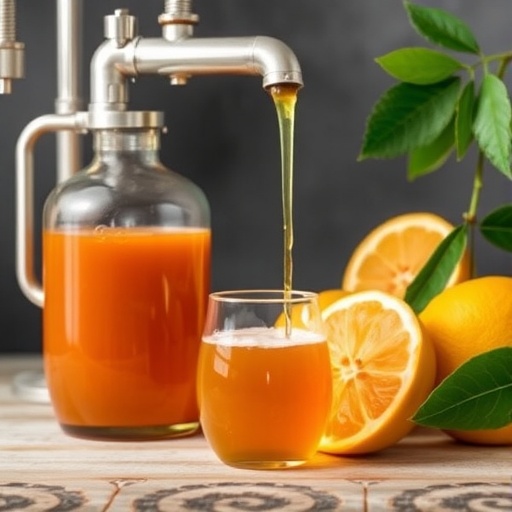In an era where sustainability and waste valorization have become paramount, a recent study published in the esteemed journal “Waste Biomass Valor” sheds light on a groundbreaking method to enhance citric acid production using waste molasses. The research, conducted by Ali S., Iqbal M.M., and Ahmad M.U., presents a novel approach by manipulating heavy metal concentrations through the use of a soil-inhabited mutagen of the fungus Aspergillus niger. This innovative strategy not only optimizes citric acid yield but also embodies a significant step forward in sustainable biotechnology.
Citric acid, a vital organic acid widely used in food and beverage industries, pharmaceuticals, and biotechnological applications, is often synthesized through fermentation processes. Traditionally, these processes require clean substrates that can be resource-intensive. However, the utilization of waste materials like molasses—a byproduct of sugar refining—could drastically reduce costs and ecological footprints if optimized properly. The implications of this study could pave the way for more sustainable practices in citric acid production, an essential compound in various industries.
The research begins by detailing the drawbacks associated with using waste molasses directly for citric acid fermentation. Molasses often contains high concentrations of heavy metals, which can inhibit microbial growth and metabolic processes. This represents a significant challenge in efficiently converting this waste product into valuable biochemicals. By addressing this issue head-on, the researchers sought to uncover a method to reduce heavy metal concentration, thus enhancing the molasses’ suitability for fermentation.
Employing a strain of Aspergillus niger, renowned for its citric acid production capabilities, the authors of the study utilized mutagenesis techniques to develop a soil-inhabited variant of the fungus. This adapted strain exhibited a remarkable resilience to the heavy metals typically found in molasses, which allowed for improved fermentation conditions. This unique adaptation enabled the researchers to explore and quantify the potential increases in citric acid yield through optimized fermentation processes.
The experimental design incorporated various trials to assess the effectiveness of the soil-inhabited mutagen in reducing heavy metals while simultaneously enhancing citric acid productivity. The researchers meticulously monitored the growth rates of the mutated Aspergillus niger under controlled conditions, noting the organism’s adaptive responses to the presence of heavy metals. By carefully adjusting nutrient concentrations, pH levels, and fermentation times, the scientists were able to maximize citric acid yields from waste molasses.
As the study progressed, the results began to reveal a promising correlation between reduced heavy metal concentrations and increased citric acid production. The findings suggested that the mutated Aspergillus niger was able to not only tolerate but also thrive in an environment somewhat hostile due to high metal concentrations. This adaptability is crucial, as it showcases the potential of using genetically modified organisms in bioproduction processes, paving the way for innovative solutions in waste utilization.
Moreover, the implications of this study extend beyond just citric acid production. The methods developed and insights gained could be translated into broader applications for bioremediation of heavy metal-contaminated environments. The research prompts discussions on the dual utility of microorganisms: not only can they be used to convert waste into valuable products, but they can also help in cleaning up pollutants from the environment, contributing to a circular economy.
The emotional and economic aspects of utilizing waste materials cannot be overstated. The food industry generates large quantities of waste that pose disposal challenges, particularly in developing regions. By turning waste molasses into a profitable product, this research offers a novel strategy for addressing both environmental concerns and economic viability. It redefines waste from being a burden to becoming an asset, thus generating new income streams for industries reliant on sugar production.
Continuous research and development in this field are essential as industries strive toward more sustainable practices. This work exemplifies how academic inquiry can lead to practical solutions for real-world problems. The ability to produce citric acid sustainably not only meets industry demands but also aligns with global efforts to reduce waste and optimize resource use. It emphasizes the importance of interdisciplinary approaches in solving complex problems that require innovative thinking and cooperative efforts across sectors.
The study’s findings serve as a call to action for researchers and practitioners alike. Increased funding and support for research initiatives focusing on waste valorization, microbial biotechnology, and sustainable practices could accelerate advancements in this field. Collaboration among academic institutions, industries, and policymakers is essential to ensure these promising findings translate into widespread adoption.
In conclusion, the research conducted by Ali and colleagues presents a significant advance in the field of biotechnological waste utilization. By improving citric acid production from waste molasses through the innovative use of a mutagenized strain of Aspergillus niger, the study offers a valuable contribution to the discussion of sustainable practices in chemical production. This groundbreaking work exemplifies how leveraging nature’s own mechanisms can lead to both environmental and economic benefits.
As we look to the future, the potential applications of this research could have far-reaching effects on how industries approach waste, sustainability, and production in general. As more studies delve further into the capabilities of microorganisms and their role in converting waste to wealth, we might just be on the brink of a biotechnological revolution.
In summary, this research highlights the pressing need for modern strategies in bioproduction and waste management. The ongoing evolution of techniques and methodologies within biotechnology brings forth a promising horizon, where sustainable practices are not just aspirational but indeed achievable. As industries continue to adapt to environmental imperatives, studies like this one will be instrumental in shaping a greener, more sustainable future for all.
Subject of Research: Citric Acid Production from Waste Molasses Using Aspergillus niger
Article Title: Improved Citric Acid Productivity from Waste Molasses by Lowering Heavy Metal Concentration Through Soil-Inhabited Mutagen of Aspergillus Niger
Article References:
Ali, S., Iqbal, M.M., Ahmad, M.U. et al. Improved Citric Acid Productivity from Waste Molasses by Lowering Heavy Metal Concentration Through Soil-Inhabited Mutagen of Aspergillus Niger.
Waste Biomass Valor (2025). https://doi.org/10.1007/s12649-025-03281-5
Image Credits: AI Generated
DOI: 10.1007/s12649-025-03281-5
Keywords: Citric Acid, Waste Molasses, Aspergillus niger, Heavy Metals, Bioproduction, Sustainability, Biotechnology.




